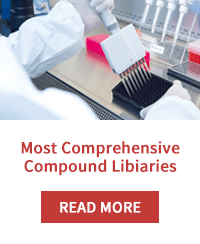

A dye is a colored substance that has an affinity for the substrate applied to it.
Based on selective fluorescent staining with Nile red (NR), and then density extraction and filtration, a new method for the analysis of microplastics in environmental samples was proposed. Dyes stick to plastic surfaces and fluoresce when irradiated with blue light. Fluorescence emission was detected by simple photographic examination of an orange filter. Image analysis allows the identification and counting of fluorescent particles. The enlarged image can be recorded and tiled to cover the entire filter area, thus detecting particles of a few microns. The discoloration properties of Nile red also provide the possibility of plastic classification based on the surface polar characteristics of the recognized particles. Anthocyanin dye can be used to quantify the amount of dsDNA in the sample. The linearity of fluorescence was obtained by measuring the fluorescence intensity at the optimal excitation and emission maxima as a function of the DNA amount of the six dyes.
Targetmol provides dye reagents, which are widely used in fluorescent labeling and biochemical detection, and is committed to providing high-quality reagent products and services for life science research.
| Cat. No. | Product name | CAS No. | Purity | Chemical Structure |
|---|---|---|---|---|
| TD0072 | AMCA-X, SE [3-(7-amino-4-methyl-2-oxo-2H-chromen-3-yl)propanoic acid, succinimidyl ester] | 216309-02-3 | 98% |
![AMCA-X, SE [3-(7-amino-4-methyl-2-oxo-2H-chromen-3-yl)propanoic acid, succinimidyl ester]](https://www.targetmol.com/file/group3/M00/01/56/CgoaEWYctq2EWYZxAAAAABtNU7A839.png)
|
| AMCA-X, N-succinimidyl ester is an amine-reactive, UV-excitable, blue fluroscent dye. | ||||
| TD0027 | Super Fluor 680 | TD0027 | 98% |
|
| Super Fluor 680 dye is a bright, near-IR fluorescent dye with excitation ideally suited for the 633 nm laser line. For stable signal generation in imaging and fl... | ||||
| TD0058 | 6-TRITC | 80724-20-5 | 98% |
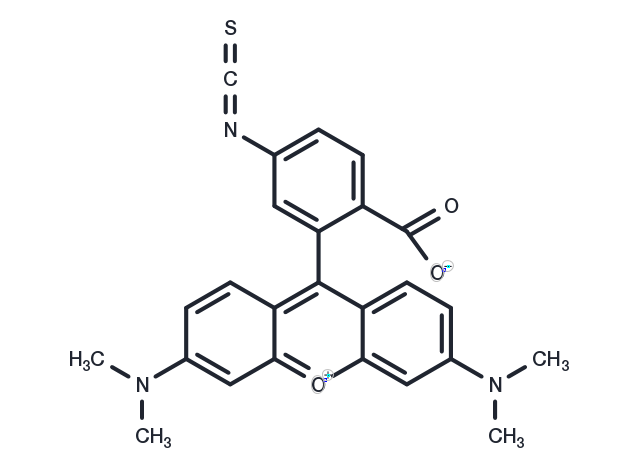
|
| 6-TRITC can bind to various antibody proteins, and the antibody does not lose its specificity of binding to certain antigens, and has a strong yellow-green fluor... | ||||
| TD0045 | Cy7 ethylenediamine | TD0045 | 98% |
|
| Cy7 ethylenediamine is commonly used in biomolecular labeling, fluorescence imaging and other fluorescence biological analysis. | ||||
| TD0059 | RBITC [Rhodamine B 5-isothiocyanate] | 36877-69-7 | 98% |
![RBITC [Rhodamine B 5-isothiocyanate]](https://www.targetmol.com/file/group3/M00/00/03/CgoaEGYZDQSEHSsvAAAAAJ5R_fY387.png)
|
| Rhodamine B isothiocyanate is a mixture of isomers for fluorescence applications including fluorescent marking of proteins. It is derivatite of phenolphtalein. | ||||
| TD0100 | 5(6)-TRITC [Tetramethylrhodamine-5-(and-6)-isothiocyanate] *Mixed isomers* | 95197-95-8 | 98% |
![5(6)-TRITC [Tetramethylrhodamine-5-(and-6)-isothiocyanate] *Mixed isomers*](https://www.targetmol.com/file/group3/M00/00/A2/CgoaEWYckzmEfHTYAAAAAIrnOz0719.png)
|
| 5(6)-TRITC [Tetramethylrhodamine-5-(and-6) -Isothiocyanate] *Mixed isomers* is used to label antibodies with strong fluorescent dyes | ||||
| TD0021 | Super Fluor 488 | TD0021 | 98% |
|
| Super Fluor 488 dye is a bright, green-fluorescent dye with excitation ideally suited to the 488 nm laser line. For stable signal generation in imaging and flow ... | ||||
| TD0022 | Super Fluor 488, SE | TD0022 | 98% |
|
| This Super Fluor 488, SE is a reactive dye for the labeling of antibodies, peptides, proteins, tracers, and amplification substrates optimized for cellular label... | ||||
| TD0038 | Cy5diacid, SE | TD0038 | 98% |
|
| Cy5 diacid, SE is commonly used in biomolecular labeling, fluorescence imaging and other fluorescence biological analysis. | ||||
| T15040 | Cy 3 Non-Sulfonated | 146397-20-8 | 98% |
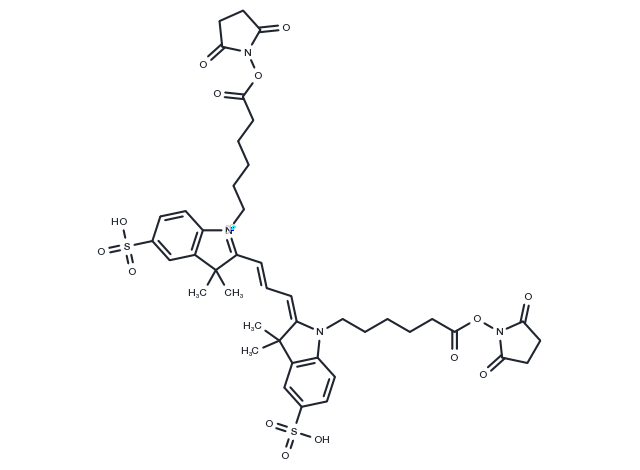
|
| Cy 3 Non-Sulfonated (Cyanine3) is a fluorescent label for protein and nucleic acid. | ||||
| TD0003L | CelGreen nucleic acid gel stain *10,000× concentrate in DMSO* | TD0003L | 98% |
|
| CelGreen nucleic acid gel stain 10,000× concentrate in DMSO is a fluorescent dye with a unique involvement that binds to all dsDNA double helix sulcus regions. | ||||
| TD0067 | 5(6)-ROX [5-(and 6)-Carboxy-X-rhodamine] *Mixed isomers* | TD0067 | 98% |
|
| ROX dyes have a strong red fluorescence.Their excitation and emission wavelengths are longer than those of traditional rhodamine dyes.They are used as labels for... | ||||
| TD0018 | Sulfo-Cy7 cadaverine | TD0018 | 98% |
|
| Sulfo-Cyanine7 is an improved analog of Cy7 fluorophore with quantum yield improved by 21%, and higher photostability. This fluorescent dye is especially useful ... | ||||
| TD0032 | Cy3 diacid, SE | TD0032 | 98% |
|
| Cy3 diacid, SE is often used in biomolecular labeling, fluorescence imaging and other fluorescence biological analysis. | ||||
| TD0083 | DiIiodide1,1‘-Dioctadecyl-3,3,3’,3‘-tetramethylindocarbocyanine iodide] | TD0083 | 98% |
|
| DiI, DiO, DiD and DiR dyes are a family of lipophilic fluorescent stains for labeling membranes and other hydrophobic structures. The fluorescence of these envir... | ||||
| TD0043 | Cy5.5 ethylenediamine | TD0043 | 98% |
|
| Cy5.5 ethylenediamine is commonly used in biomolecular labeling, fluorescence imaging and other fluorescence biological analysis. | ||||
| TD0070 | 6-ROX, SE | 216699-36-4 | 98% |
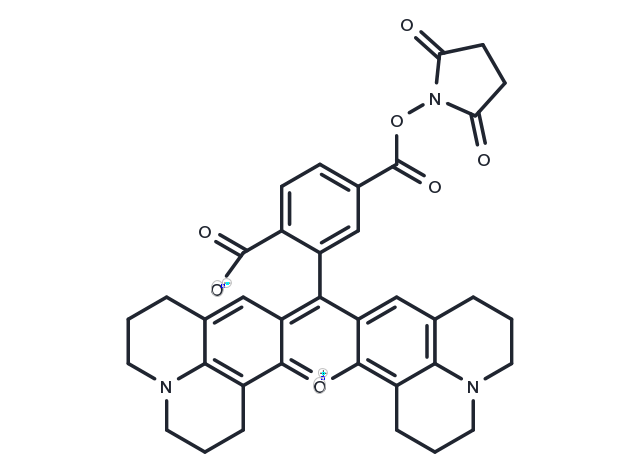
|
| The isomeric 6-ROX, SE is an amine-reactive form of carboxy-X-rhodamine and is widely used for oligonucleotide labeling and automated DNA sequencing applications... | ||||
| TD0002 | CelRed nucleic acid gel stain *10,000× concentrate in water* | TD0002 | 98% |
|
| 1) Non-toxicity: The unique oiliness and high molecular weight characteristics of CelRed prevent it from penetrating cell membranes into cells, and Ames test res... | ||||
| TD0057 | 5-TRITC | 80724-19-2 | 98% |
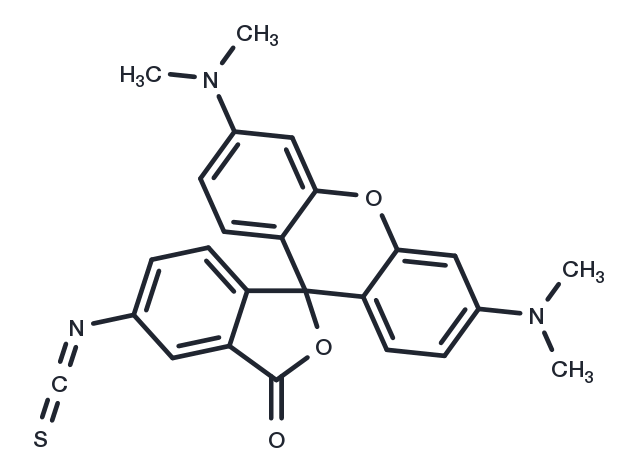
|
| 5-TRITC can bind to various antibody proteins, and the antibody does not lose its specificity of binding to certain antigens, and has a strong yellow-green fluor... | ||||
| TD0040 | Cy5 cadaverine | TD0040 | 98% |
|
| Cy5 cadaverine is commonly used in biomolecular labeling, fluorescence imaging and other fluorescence biological analysis. | ||||
